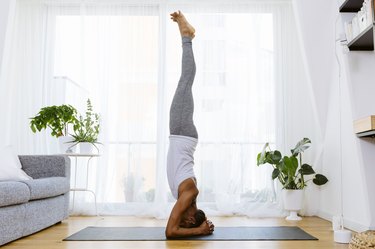
For some, a graceful headstand represents the epitome of mind-body balance and physical agility that you get from a regular yoga practice. For others, the sheer challenge — and sometimes, the intimidation factor — of conquering a difficult pose like headstand is another part of its appeal.
Headstand (or in Sansktrit, sirsasana, which is sometimes spelled shirshasana) is an inversion — a yoga pose defined as putting your head below your heart or your head below your hips. That helps relax strain on the heart, harmonize your circulation and rush oxygen-rich blood to your upper body and, in particular, your brain, according to George Mason University.
Video of the Day
And when done correctly, sirsasana engages many muscles, including those of the arms, upper back and core. Here are all the benefits of headstands.
Warning
A headstand requires moderate shoulder strength and can be dangerous if the practitioner is not ready to support his or her own weight in an upside-down orientation. A beginner to yoga shouldn't try a headstand, says the National Center for Complementary and Integrative Health.
1. Strengthens the Upper Body
When a headstand is done properly, the body is supported primarily by the muscles of the shoulders and upper back. Contraction of the trapezius and deltoid muscles protect the head and neck in this posture.
Tip
When shoulders are too weak, headstands can be dangerous because they compress the vertebrae of the cervical spine, which can lead to permanent damage and pain.
Yoga Journal suggests that beginners try a headstand against a wall supporting all their weight on their forearms, with a huge assist from the shoulders. That way the cervical section of your spine is protected.
2. Builds Core Strength
In order to hold a straight headstand, a practitioner must engage the abdominal muscles — including the obliques, the rectus abdominis and the transverse abdominis. Poor form — with bent legs or flexed hips, for instance — could indicate weakness of the core.
A strong core can position your hips directly over the chin and extend the hip flexors so your legs are vertical. The core is strengthened particularly if the practitioner lifts or lowers both legs at once to come into and out of the headstand.
Related Reading
3. Helps Improve Digestion
When the body is upside down, the pituitary gland, which plays a role in healthy digestion, is stimulated, according to Yoga Journal. The pituitary gland is a pea-shaped endocrine gland in the brain responsible for metabolism, turning food into usable energy.
It also regulates hormone production and the process of water re-absorption in the kidneys. Headstands are recommended for irritable bowel syndrome and other digestive ailments, as they reorient the colon and intestines, encouraging bowel movements.
4. Nourishes the Face
Many yoga teachers like to say that a headstand is the asana equivalent of a facial because it stimulates blood flow to the face. Increased circulation to the skin of the cheeks and forehead means oxygenation and sustained youth of the facial cells.
Practitioners should take care not to remain in a headstand for too long; some people report a "bursting" feeling or broken blood vessels in the face. Ten breaths, or one to three minutes, is enough to reap a headstand's benefits.
5. Can Help Ease With Depression
Because headstands stimulate the pituitary gland — which is responsible for releasing endorphins, the body's "happy" hormones — they can be prescribed to alleviate the sadness and lethargy associated with depression.
Headstands also reduce the production of cortisol, the stress hormone, and increase blood flow to the brain, stimulating the production of melatonin, dopamine and serotonin, all hormones that help regulate mood.
6. Helps Relieve Stress
One of the pieces of sirsasana research that deals specifically with headstands is a small trial of 40 volunteers, published in January 2003 in Indian Journal of Physiology and Pharmacology. The study confirmed that the headstand posture did in fact activate the sympathetic nervous system, which might be part of the reason for the pose's mind-calming reputation.
How to Do Sirsasana Pose Safely

- Kneel on the floor and grab your elbows with your opposite hands.
- Place your forearms on the floor. Rest the back of your head in between your hands. Your hands should form a crown around your head.
- Keeping the balls of your feet on the floor, straighten your knees to raise them off of the floor.
- Brace your core and walk your feet toward your elbows.
- Slowly extend one leg toward the ceiling.
- Squeeze your core to pull the other up toward the ceiling.
- Tense your glutes, core and shoulders to keep your body in a straight line. Point your toes.
- Hold, then lower one leg at a time to lower back to the starting position.
Aside from the above-mentioned headstand benefits and the fact that complaints about injuries caused by sirsasana aren't widely advertised and might not even be discussed in some yoga classes, they do exist.
In a 2013 review in PLOS One, researchers note that sirsasana was by far the most commonly cited yoga posture for having caused injury. The resulting injuries were sometimes quite serious, including types of stroke and loss of sight.
Some of the best things you can do to ensure maximal safety include doing yoga — especially inversions and advanced poses such as sirsasana — under the guidance of a certified yoga instructor who is experienced in that style.
Also, if you have any injuries that might contraindicate headstands or inversions — especially problems with your head, neck or back — talk with a medical professional to find out if you should avoid sirsasana altogether. If you're cleared to do headstands, discuss your situation with the instructor before class so they can suggest appropriate variations.
Beginners should avoid starting with advanced yoga poses such as sirsasana. Even if you're fit from other pursuits, it takes time for your body to adapt to the different challenges posed by doing yoga.
In a conscientiously taught yoga class, appropriate preparation is an important component of doing inversions. Some classes even focus exclusively on inversions to ensure appropriate preparation, understanding of technique and supervision.
Meanwhile, if you want to see for yourself whether inversions will benefit you, there's no need to go straight to the headstand, which is considered to be one of the most challenging inversions possible. The commonly practiced — and much gentler — downward-facing dog is also considered an inversion.
Downward Facing Dog
- Start on all fours, with your weight in your hands and knees.
- Tuck your toes under and lift your knees as you push back into your heels. Your legs should be hip-width apart. Your arms should be at shoulder width, fingers spread wide.
- Pull the belly toward the spine and press your hips back to sink the heels down.
- Stay here for five breaths before slowly lowering down to all fours or child’s pose.
Sirsasana Variations
A few particular points to keep in mind include using a folded blanket or sticky yoga mat to pad your head and forearms, retracting and depressing your shoulder blades (bringing them close to your spine and sliding them toward your hips) for support and stability, and bringing both legs up into the pose together, according to Yoga Journal.
Although Yoga Journal recommends bending your knees if necessary to get into sirsasana with your legs together, a small July 2015 study in the Journal of Bodywork and Movement Therapies, contradicts that.
The study found that entering sirsasana with both legs straight may help reduce the load on your head and neck, as well as slowing the overall rate of loading, whereas entering a headstand with your knees bent, whether one leg at a time or both, has the opposite effect.
Another side benefit of entering sirsasana with both legs is that it requires you to build up more core strength before you're able to manage it.
And although many yogis describe the crown of your head as resting lightly on your mat during the pose, that's still quite a bit of weight — between 40 and 48 percent of total body weight on the head and neck, according to the JBMT study. All the more reason to decline headstands, or pursue them very carefully, if you have any contraindications at all.
- Yoga Journal: "Supported Headstand"
- National Center for Complementary and Integrative Health: "Yoga: What You Need to Know"
- Indian Journal of Physiology and Pharmacology: "Effects of sirsasana (headstand) practice on autonomic and respiratory variables"
- George Mason University: "Diary of a Happy Yogi: Headstands"
- Frontiers in Human Neuroscience: "Neuroprotective effects of yoga practice: age-, experience-, and frequency-dependent plasticity"
- PLOS One: "Adverse Events Associated with Yoga: A Systematic Review of Published Case Reports and Case Series"
- Journal of Bodywork and Movement Therapies: "Sirsasana (headstand) technique alters head/neck loading: Considerations for safety"
- Yoga Journal: "Everybody Upside-Down"